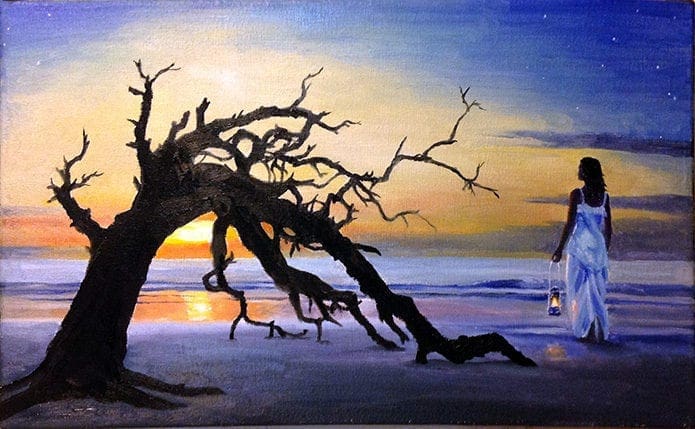
The woman on the shore
By LORRAINE V. MURRAY, Commentary | Published October 20, 2016
I found the bottle tucked away on a basement shelf with a label, in my husband’s handwriting: “Storm-charged rainwater from intense storm in late evening on August 22, 1996, which lasted from 7 to 10 p.m. with much lightning.”
Did he have a use in mind for the rainwater when he bottled it? I wondered. Probably not, I decided, anymore than children have a reason for gathering lightning bugs on summer nights.
My late husband, you see, glimpsed wonder in the everyday world, whether that meant carrying stones from the creek to put in our yard; finding gnarled tree branches for walking sticks; or videotaping the mysterious movement of the moon across the sky.
When he recited the Creed, he savored the words calling God “maker of heaven and earth, of all things visible and invisible” because, for him, invisibility opened up intriguing possibilities like angels, elves and fairies—and who knows what other enchanting beings?
As someone still inhabiting this earthly realm, I find myself at times checking his shirt pockets, seeking some final message from him.
So far I’ve had no luck, although, on the day he died, I discovered a tiny leaf in his pocket—which I stashed away in the bedside table. Rather oddly, it is now one year and two months later—and the leaf remains intact.
To me, it’s a quiet testimony to things—visible and invisible—that stretch the limits of possibility.
On our last vacation, Jef was out swimming in the Atlantic one day and had to struggle to free himself from a dangerous riptide. When he returned to the condo, he was visibly shaken and said something that later seemed prescient: “You almost lost me today.”
I gasped at the thought, not realizing that in two days, the words would come true.
Months later, I wondered whether he’d had an inkling of the future when he fashioned his last painting—which shows a woman alone on the shore, gazing out to sea and holding a lamp.
When he first showed me the image, I immediately was drawn to it but also was puzzled. Was she saying goodbye to, or awaiting, her sweetheart?
As for the bottle of rainwater, I took it out to the cemetery, stopping along the way to purchase a cluster of hydrangeas in Jef’s favorite color, blue.
As I poured the lightning-charged liquid upon my sweetheart’s grave, tears fell from my eyes and mixed with the elixir that had cascaded from the sky long ago.
Who could have predicted that the rainwater Jef collected would one day drench his grave? Who knows when each of us will journey from the visible to the invisible realm?
As All Souls’ Day approaches, the days are growing shorter and the shadows lengthening, and I find myself in his studio, standing silently before the painting—which no longer perplexes me.
I now believe the woman on the shore is bidding farewell to a man she loves dearly—while also awaiting a reunion. The dark tree bespeaks death, while the lamp symbolizes the brilliance of Christ.
And this mixture of sorrow and hope, light and dark, conveys my husband’s final message: “Wait for me on the shore—and keep the light of Christ forever in your heart. Savor each moment in this earthly realm, where storms still evoke magic and wonder and awe.”
Artwork (“The Lamplighter,” oil on canvas) by Jef Murray. Lorraine’s email address is lorrainevmurray@yahoo.com.